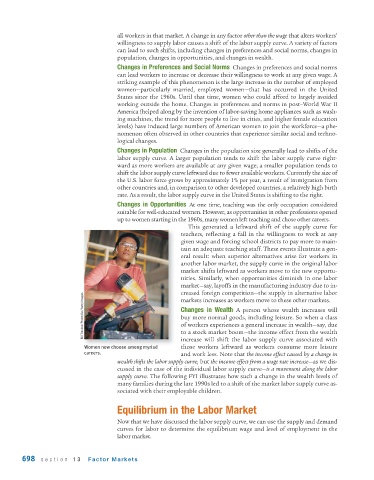Page 740 - Krugmans Economics for AP Text Book_Neat
P. 740
all workers in that market. A change in any factor other than the wage that alters workers’
willingness to supply labor causes a shift of the labor supply curve. A variety of factors
can lead to such shifts, including changes in preferences and social norms, changes in
population, changes in opportunities, and changes in wealth.
Changes in Preferences and Social Norms Changes in preferences and social norms
can lead workers to increase or decrease their willingness to work at any given wage. A
striking example of this phenomenon is the large increase in the number of employed
women—particularly married, employed women—that has occurred in the United
States since the 1960s. Until that time, women who could afford to largely avoided
working outside the home. Changes in preferences and norms in post–World War II
America (helped along by the invention of labor-saving home appliances such as wash-
ing machines, the trend for more people to live in cities, and higher female education
levels) have induced large numbers of American women to join the workforce—a phe-
nomenon often observed in other countries that experience similar social and techno-
logical changes.
Changes in Population Changes in the population size generally lead to shifts of the
labor supply curve. A larger population tends to shift the labor supply curve right-
ward as more workers are available at any given wage; a smaller population tends to
shift the labor supply curve leftward due to fewer available workers. Currently the size of
the U.S. labor force grows by approximately 1% per year, a result of immigration from
other countries and, in comparison to other developed countries, a relatively high birth
rate. As a result, the labor supply curve in the United States is shifting to the right.
Changes in Opportunities At one time, teaching was the only occupation considered
suitable for well-educated women. However, as opportunities in other professions opened
up to women starting in the 1960s, many women left teaching and chose other careers.
This generated a leftward shift of the supply curve for
teachers, reflecting a fall in the willingness to work at any
given wage and forcing school districts to pay more to main-
tain an adequate teaching staff. These events illustrate a gen-
eral result: when superior alternatives arise for workers in
another labor market, the supply curve in the original labor
market shifts leftward as workers move to the new opportu-
nities. Similarly, when opportunities diminish in one labor
market—say, layoffs in the manufacturing industry due to in-
creased foreign competition—the supply in alternative labor
Bill Truslow/Photodisc/Getty Images Changes in Wealth A person whose wealth increases will
markets increases as workers move to these other markets.
buy more normal goods, including leisure. So when a class
of workers experiences a general increase in wealth—say, due
increase will shift the labor supply curve associated with
those workers leftward as workers consume more leisure
Women now choose among myriad to a stock market boom—the income effect from the wealth
careers. and work less. Note that the income effect caused by a change in
wealth shifts the labor supply curve, but the income effect from a wage rate increase—as we dis-
cussed in the case of the individual labor supply curve—is a movement along the labor
supply curve. The following FYI illustrates how such a change in the wealth levels of
many families during the late 1990s led to a shift of the market labor supply curve as-
sociated with their employable children.
Equilibrium in the Labor Market
Now that we have discussed the labor supply curve, we can use the supply and demand
curves for labor to determine the equilibrium wage and level of employment in the
labor market.
698 section 13 Factor Markets

